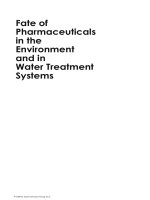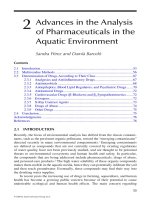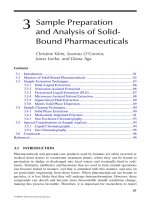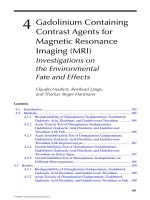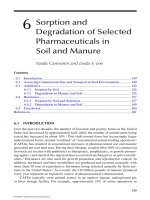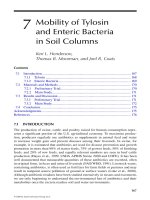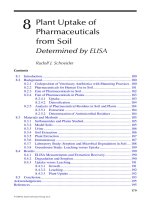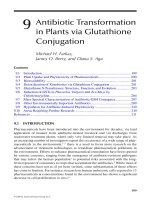Fate of Pharmaceuticals in the Environment and in Water Treatment Systems - Chapter 6 pptx
Bạn đang xem bản rút gọn của tài liệu. Xem và tải ngay bản đầy đủ của tài liệu tại đây (382.86 KB, 27 trang )
139
6
Sorption and
Degradation of Selected
Pharmaceuticals in
Soil and Manure
Nadia Carmosini and Linda S. Lee
6.1 INTRODUCTION
Overthepasttwodecades,thenumberoflivestockandpoultryfarmsintheUnited
States has decreased by approximately half, while the number of animal units being
raised has increased by about 10%.
1
Thisshifttowardfewerbutincreasinglylarger
industrialized farms, termed “conned” or “concentrated animal feeding operations”
(CAFOs), has resulted in concomitant increases in pharmaceutical use and manure
generatedperunitlandarea.Duringtheirlifespan,roughly60to80%ofcommercial
livestockaretreatedwithantibioticsastherapeutic,prophylactic,orgrowthpromot-
ing agents,
2
andmuchoftheingesteddoseisexcretedunchangedorasactivemetab-
olites.
3
Hormones are also used for growth promotion and reproductive control. In
addition,hormonesandtheirmetabolitesareproducedandexcretednaturally,with
more than 50 tons of reproductive hormones being released annually by farm ani-
mals in the United States.
4
Asaresult,the130billionpoundsofmanureproduced
everyyearrepresentanexpansivesourceofpharmaceuticalcontamination.
CAFOstypicallystoreanimalwastesinanoutdoorlagoon,undergroundpit,
or litter storage facility. For example, approximately 23% of swine operations in
Contents
6.1 I
ntroduction 139
6.2 Assessing Contaminant Fate and Transport in Soil Environments 140
6.3 Antibiotics 142
6.3.1 Sorption by Soil 142
6.3.2 Degradation in Manure and Soil 155
6.4 Hormones 157
6.4.1 Sorption by Soil and Sediment 157
6.4.2 Degradation in Manure and Soil 159
6.5 Conclusion 160
References 161
© 2008 by Taylor & Francis Group, LLC
140 Fate of Pharmaceuticals in the Environment and in Water Treatment Systems
the United States use lagoons; 57% use below-ground pits; and the remaining 20%
employotherstoragetechniques,suchasmanurepiles.
5
Lagoons and pits contain
liquid, sludge, and solids that are periodically pumped out and injected or surface
appliedtoagriculturallandasaneconomicaldisposalstrategythatcapitalizesonthe
waste’sfertilizervalue.MostCAFOspumpdownordewaterlagoonsthreetofour
timesannually(58%),whileothersdewaterlessthattwiceayear(16%)orneveratall
(26%).
5
During these variable residence times, concentrations of excreted residues
intheliquidphasemaydissipateasaresultofanaerobicdegradationandsorptionto
particulates. After land application, aerobic degradation and sorption to soils further
reducethepersistenceandmobilityofpharmaceuticalsintheenvironment.Inasim
-
il
armanner,municipalwastewatertreatmentplantsgeneratepharmaceutical-laden
biosolidsandwastewaterefuents,whicharedisposedbylandapplicationandused
tomeetirrigationdemandsinaridregions.Recentsurveysoforganiccontaminants
in wastewater efuents and biosolids have reported a suite of antibiotics and other
pharmaceuticals, albeit at concentrations substantially lower than those in livestock
andpoultrymanures(lessthanμg/kgvs.mg/kglevels).
6,7
Concern over potential negative impacts of biologically active pharmaceuticals
on nontarget organisms and ecosystem health has prompted many laboratory-scale
andafeweld-scaleassessmentsoftheirenvironmentalfate.Severalreviewsof
thisinformationhavebeenpublishedinthepast5years,especiallyforveterinary
pharmaceuticals.Mostrecently,Leeetal.
8
summarizedwhatisknownontheoccur-
rence, environmental fate, ecological impacts, and analytical techniques associated
with veterinary antibiotics and hormones. Khanal et al.
9
reviewed the removal rates
andmechanismsfornaturalestrogensinwastewatertreatmentsystems.Sarmahet
al.
10
compiled data on veterinary antibiotic use and sales trends for several countries,
including the United States, the European Union, New Zealand, Kenya, Canada,
Japan,China,andRussia.Kumaretal.
11
summarized veterinary antibiotic occur-
rence, excretion rates, and subsequent environmental fate, including sorption, degra-
dat
ion, and transport. Preceding these reviews, Tolls
12
and Thiele-Bruhn
13
provided
a review of the sorption and presence of veterinary antibiotics in soils, respectively.
In this chapter we will emphasize the studies that have been particularly instrumen
-
ta
lingleaninginformationontheprocessesthatdeterminethesorptionbehaviorof
antibiotics, as well as present an overview of emerging research on the degradation
of antibiotics and hormones in the environment.
6.2 ASSESSING CONTAMINANT FATE AND
TRANSPORT IN SOIL ENVIRONMENTS
Thepotentialforantibioticsandhormonestocontaminateandadverselyimpactthe
environmentisdirectlyinuencedbytheirmobilityandpersistenceinanimalwastes
andsoils.Asaresult,manystudieshaveexaminedthedissipationandpartitioningof
these contaminants in environmental matrices, such as soil, manure, organic matter,
clays, metal oxides, and oxyhydroxides. For the most part, either batch equilibrium
or column displacement techniques have been used. The interpretation and applica
-
ti
onofdatafromtheseexperimentsrequirescarefulconsiderationoftheexperimen-
ta
l design employed. In batch equilibrium experiments, multiple concentrations of a
© 2008 by Taylor & Francis Group, LLC
Sorption and Degradation of Selected Pharmaceuticals in Soil and Manure 141
sorbate are equilibrated with a constant amount of sorbent in an electrolyte solution
(e.g., 5 mM CaCl
2
). Ideally, experiments should be conducted using a sorbent mass
to solution volume ratio and contaminant concentration range that ensure 50 ± 25%
sorption of the applied compound when near-equilibrium conditions are attained.
This degree of partitioning facilitates accurate quantication of sorbate concentra
-
t
i
onsinboththesolid(C
s
, mg/kg or mmol/kg) and aqueous (C
w
,mg/Lormmol/L)
phases. These concentrations are plotted against one another to construct a sorption
isotherm, which can be described with one of three commonly used equilibrium
based models: (1) Linear equation,
K
d
= C
s
/C
w
,whereK
d
(L/kg) is the linear distri-
bution coefcient; (2) Freundlich equation, C
s
= K
f
C
w
N
,whereK
f
(mg
1-N
L
N
kg
–1
or
mmol
1–N
L
N
kg
–1
)istheFreundlichsorptioncoefcientandN (unitless) is a measure
of isotherm nonlinearity; and (3) Langmuir equation, C
s
= C
s,max
K
L
C
w
/(1+K
L
C
w
),
where K
L
(L/mgorL/mmol)istheLangmuirafnitycoefcientandC
s,max
is the
maximum monolayer adsorption capacity (mg/kg or mmol/kg). Comparisons among
sorbentscanbemadeindependentoflinearityusingnonlinearmodelcoefcientsby
estimating a concentration-specic sorption coefcient (
K
d
*
) at an equilibrium con-
centration (C
w
) that falls within the experimental range: K
d
*
= K
f
C
w
N–1
.
Direct quantication of the contaminant in both phases is critical for assessing
potentiallyreversiblesorptionandensuringthatthelossoftheparentcompound
from solution is due only to sorption. If biotic and abiotic transformations, volatiliza
-
t
i
on,sorptiontolabware,andotherlossprocessesaresignicantandattributedto
sorption, inated estimates of sorption will be obtained. Methods commonly used to
inhibit biodegradation include sterilization of the sorbent by
60
Co irradiation, auto-
claving,andltration,orincorporatingadiluteconcentrationofanantimicrobial,
such as sodium azide (NaN
3
)ormercuricchloride(HgCl
2
), in the batch reactor.
14,15
When these steps are not taken, batch experiments can be used to assess biotic
transformations in conjunction with sorption as long as concentrations of the parent
compound and metabolites in both sorbed and solution phases are determined. To a
certainextent,biotictransformationsmayoccurevenaftersystemshavebeensteril
-
izedduetoextracellularenzymesthatremainactive.
In column displacement studies, the movement of a contaminant front or pulse
throughapackedorintactsoilcolumnisevaluatedovertime.Informationonthe
chemical’spartitioningbetweenthesoilandaqueousphasesisderivedfromaplotof
theoutowconcentrationvs.time,calledabreakthroughcurve,whichiscompared
to the breakthrough curve for a nonsorbing, conservative tracer (e.g., Cl
–
,Br
–
). Com-
pared to batch experiments, column studies may more closely mimic the spatial and
temporal processes of a eld scenario, particularly when intact soil cores are used.
Contaminants moving through a soil prole may not persist in space and time for a
sufcientlylongperiodoftimetoreachequilibrium;thus,observationsunderow
conditions can provide additional insights into the processes that affect a chemical’s
persistenceandmobilityinsoils.However,mostcolumnstudiesareconductedunder
saturatedsteady-stateowconditions,whicharefarnotrepresentativeofvertical
transportthroughthevadosezonewhereunsaturatedtransientowisthenorm.
Also,evencolumnstudiesperformedwithintactcoresoftencannotreecttheeffect
of eld-scale heterogeneity on fate and transport phenomena or adequately represent
the magnitude of macropore ow at the eld scale.
16
© 2008 by Taylor & Francis Group, LLC
142 Fate of Pharmaceuticals in the Environment and in Water Treatment Systems
Oneofthemostchallengingaspectsofbatch,column,andeld-scaleexperi-
ments is the accurate quantication of low analyte concentrations in complex sample
matrices.Manyspectroscopictechniques,suchasultraviolet-visible(UV-VIS),uo-
re
scence, and mass spectrometry, are often plagued by positive or negative matrix
effects, necessitating the use of internal standards or matrix-matched standards.
Finally, the use of sorption data in environmental fate models will only accurately
describe chemical partitioning in other systems with similar physicochemical prop
-
er
ties (e.g., pH, electrolyte concentration and composition, solute concentration
range,sorbentcomposition).Forexample,themagnitudeofsorptionexhibitedbya
pureclaysorbentmaydifferfromthatoftheclaywithinasoilduetothepresence
of other sorption domains and the interactions between those domains (e.g., organic
matter coatings on clay surfaces).
6.3 ANTIBIOTICS
6.3.1 SORPTION BY SOIL
Todate,researchonthefateofpharmaceuticalsisdominatedbyworkonveterinary
antibioticsinresponsetoconcernsthattheirextensiveuseinlivestockproductionis
contributing to bioactive residues in the environment. Although their physicochemi-
cal
properties are highly variable, most antibiotics are moderately water soluble and
exhibit low octanol-water partition coefcients (K
ow
) due to the presence of polar
functional groups (e.g., -C=O, -OH, -COOH, -NO
2
,-NH
2
, -CN). Some of these
functionalities are ionizable, resulting in compounds that exist as either neutral or
charged species (e.g., cations, anions, zwitterions) in proportions dependent on pH
conditions.Whileneutralmoleculespartitiontosolidphasesviarelativelyweak
van der Waals and electron donor-acceptor interactions, charged species can interact
withchargedsorbents(e.g.,organicmatter,clays,metaloxides,andoxyhydroxides)
through stronger electrostatic mechanisms, such as cation-exchange, cation-bridg
-
ing, and complexation. Table 6.1 summarizes t
he structures, class assignments,
molecular weights, acid dissociation constants (pK
a
),andusageinformationforthe
antibiotics discussed in this chapter.
For antibiotics possessing a positive charge, cation exchange has emerged as an
importantsorptionmechanism.Inworkconductedthreedecadesbeforethepresent
surgeofinterestinantibiotics,Porubcanetal.
17
examined the sorption of clindamy-
cinandtetracycline(TC)bymontmorilloniteclayoverabroadpHrange(1.5to11).
X-ray diffraction analysis showed that the clay’s interlayer spacing increased under
low pH conditions where the antibiotics’ cationic species predominated. In contrast,
thespacingremainedunchangedathighpHwhereclindamycinisneutralandTC
is predominantly anionic (+ or 0 ). Infrared radiation (IR) analyses also showed
that clindamycin decreased the intensity of the water absorption band, which was
attributed to the replacement of hydrated exchangeable cations in the clay’s inter
-
layerbyclindamycin.Underneutraltomoderatelyalkalineconditions,IRspectral
shifts indicated that sorption of the TC zwitterions (+ 0 and + ) occurred by cation
exchange as well as by the formation of a complex between the interlayer Ca
2+
cat-
ions and the antibiotic’s carbonyl group. For the uncharged clindamycin molecule,
© 2008 by Taylor & Francis Group, LLC
Sorption and Degradation of Selected Pharmaceuticals in Soil and Manure 143
TABLE 6.1
Properties of Selected Antibiotics
Antibiotic Class
Molecular
Weight
(g mol
–1
) pKa Usage
Clindamycin
CH
3
O
N
H
N
Cl
CH
3
H
HO
H
3
C
HO
OH
S
CH
3
O
Lincosamide 424.98 7.6
a
Human and veterinary therapeutic
Tetracycline
HO
CH
3
CH
3
OH
OOOOHOH
OH
NH
2
H
3
C
N
Tetracycline 444.44 3.3
b
7.68
b
9.3
b
Human and veterinary therapeutic; Livestock
growth promoter and prophylactic
Oxytetracycline
OH OH
OH
OH
N
H
OH
CH
3
HO
CH
3
H
3
C
OOO
NH
2
H
Tetracycline 460.44 3.27
b
7.32
b
9.11
b
Human and veterinary therapeutic; Livestock
growth promoter and prophylactic; Fruit
production; Aquaculture
(Continued)
© 2008 by Taylor & Francis Group, LLC
144 Fate of Pharmaceuticals in the Environment and in Water Treatment Systems
TABLE 6.1.
(Continued)
Antibiotic Class
Molecular
Weight
(g mol
–1
) pKa Usage
Chlortetracycline
Cl
HO
CH
3
H
3
C
CH
3
OH
NH
2
OOHOH
OH
OO
N
Tetracycline 478.89 3.30
b
7.44
b
9.27
b
Human and veterinary therapeutic; Livestock
growth promoter and prophylactic
Ciprooxacin
HN
F
N
N
O
OH
O
Fluoroquinolone 331.35 5.90
c
8.89
c
Human therapeutic
Enrooxacin
H
3
C
N
NN
O
OH
O
F
Fluoroquinolone 359.40 5.94
d
8.70
d
Veterinary therapeutic
© 2008 by Taylor & Francis Group, LLC
Sorption and Degradation of Selected Pharmaceuticals in Soil and Manure 145
Flumequin
F
N
CH
3
O
OH
O
Fluoroquinolone 261.25 6.5
e
Veterinary therapeutic
Oxolinic Acid
O
OH O
O
O
N
H
3
C
Quinolone 261.23 6.9
e
Veterinary therapeutic; Aquaculture
Saraoxacin
O
O
N
N
F
HN
F
OH
Fluoroquinolone 385.37 4.1
e
6.8
e
Veterinary therapeutic; Aquaculture
(Continued)
© 2008 by Taylor & Francis Group, LLC
146 Fate of Pharmaceuticals in the Environment and in Water Treatment Systems
Monensin
HO
O
O
O
O
O
O
O
H
H
H
H
H
3
C
H
3
C
CH
3
CH
3
CH
3
CH
3
CH
3
OH
HO
H
HO
H
3
C
H
3
C
Ionophore 670.88 4.2
f
Livestock growth promoter and prophylactic
Lasalocid
H
3
C
OH OH
H
OH
O
O
O
CH
3
CH
3
CH
3
CH
3
CH
3
CH
3
H
3
C
OH
H
H
H
H
H
O
Ionophore 590.80 2.6
f
Livestock growth promoter and prophylactic
TABLE 6.1.
(Continued)
Antibiotic Class
Molecular
Weight
(g mol
–1
) pKa Usage
© 2008 by Taylor & Francis Group, LLC
Sorption and Degradation of Selected Pharmaceuticals in Soil and Manure 147
Salinomycin
HO
H
3
C
O
O
CH
3
CH
3
CH
3
CH
3
CH
3
CH
3
OH
H
3
C
H
3
C
CH
3
OH O
O
O
O
O
OH
Ionophore 751.01 4.45
g
Livestock growth promoter and prophylactic
Tylosin
H
3
C
CH
3
CH
3
H
3
C
H
3
C
H
3
C
CH
3
CH
3
H
3
CCH
3
CH
3
O
O
O
O
O
OH
OH
OO
O
O
N
OH
HO
O
O
O
HO
H
3
C
Macrolid 916.11 7.7
h
Veterinary therapeutic; Livestock growth
promoter and prophylactic
Erythromycin
HO
H
3
C
CH
3
H
3
C
CH
3
CH
3
CH
3
CH
3
CH
3
CH
3
H
3
C
N
CH
3
CH
3
OH
OH
OH
HO
O
O
O
O
O
O
O
O
H
3
C
Macrolid 733.94 8.88
h
Human and veterinary therapeutic; Livestock
growth promoter and prophylactic
(Continued)
© 2008 by Taylor & Francis Group, LLC
148 Fate of Pharmaceuticals in the Environment and in Water Treatment Systems
Roxithromycin
H
3
C
H
3
C
CH
3
CH
3
H
3
C
CH
3
CH
3
CH
3
CH
3
CH
3
CH
3
CH
3
H
3
C
H
3
C
O
O
O
O
HO
O
N
OH
OH
O
N
O
O
OH
O
O
OH
Macrolid 837.05 9.28
g
Human therapeutic
Carbadox
O
–
O
–
N
+
N
O
O
CH
3
H
N
N
+
Quinoxaline 262.22 <0i9.61
i
Livestock growth promoter and prophylactic
Olaquindox
O
–
CH
3
O
–
O
OH
N
+
H
N
N
+
Quinoxaline 263.25 None
g
Livestock growth promoter and prophylactic
TABLE 6.1.
(Continued)
Antibiotic Class
Molecular
Weight
(g mol
–1
) pKa Usage
© 2008 by Taylor & Francis Group, LLC
Sorption and Degradation of Selected Pharmaceuticals in Soil and Manure 149
Sulfamethazine
H
2
N
O
O
S
H
N
N
N
CH
3
CH
3
Sulfonamide 278.32 2.28
j
7.42
j
Human therapeutic; Livestock growth
promoter and prophylactic
Sulfamethoxazole
H
3
C
N
H
N
S
NH
2
O
O
O
Sulfonamide 253.27 1.85
j
5.29
j
Human and veterinary therapeutic
Sulfapyridine
N
N
H
O
O
S
NH
2
Sulfonamide 249.29 2.30
k
8.43
k
Human therapeutic
Tiamulin
H
3
C
H
3
C
H
2
C
O
S
CH
3
CH
3
O
N
CH
3
H
3
C
OHO
Pleuromutilin 493.74 9.51
g
Veterinary therapeutic and prophylactic
(Continued)
© 2008 by Taylor & Francis Group, LLC
150 Fate of Pharmaceuticals in the Environment and in Water Treatment Systems
Triclosan
Cl
OH
O
Cl
Cl
Na 289.54 7.99
l
Commercial disinfectant
Chlorophene
Cl
OH
Na 218.68 9.96
l
Commercial disinfectant
a
Ref 17
b
Ref 22
c
Ref 36
d
Ref 38
e
Ref 42
f
Ref 43
g
Estimated with Marvinsketch
TM
( (Accessed August 11, 2007)
h
Ref 85
i
Ref 44
j
Ref 86
k
Ref 87
l
Ref 56
TABLE 6.1.
(Continued)
Antibiotic Class
Molecular
Weight
(g mol
–1
) pKa Usage
© 2008 by Taylor & Francis Group, LLC
Sorption and Degradation of Selected Pharmaceuticals in Soil and Manure 151
sorption was attributed to relatively weak physical processes (e.g., H-bonding, van
der Waals forces). No sorption was observed for either antibiotic at high pH condi
-
ti
ons (pH 11).
Recently, the importance of sorption by cation exchange has been documented
extensivelyinstudiesontetracyclineinteractionswithmodelclays,soils,andhumic
materials under varying pH and ionic strength conditions.
18–23
Therangeofthethree
pK
a
values(≈3.3to9.3,seeTable 6.1) for tetracyclines results in large shifts in the
proportion of the cation (+00), zwitterion (+ 0), and predominantly anionic spe
-
ci
es(+ )overtheenvironmentallyrelevantpHrange.Figueroaetal.
18
effectively
described pH effects on oxytetracycline (OTC) sorption using a model that included
cation exchange plus surface complexation of the + 0 zwitterion species. Previous
work on less complicated organic bases (e.g., quinoline and aromatic amines) has
shown that when cation exchange dominates contaminant binding to a sorbent,
K
d
or K
d
*
can be normalized with the soil’s cation exchange capacity (CEC) as follows:
= K
d
*
/CEC,where (L/equiv)istheCECnormalizeddistributioncoef-
cient.
24,25
Likewise,Figueroaetal.
18
derived an empirical model using species-spe-
cic sorption coefcients normalized to pH-dependent CEC
thatareweightedbythepH-dependentfractionofeachspecies(f
+00
, f
+
0
, f
+
) as
follows:
,whic htthedatawellfor
OTC sorption by Na-saturated montmorillonite in 10 mM sodium bicarbonate buf
-
fer.
18
Estimated values for (70 800 L/equiv) were 20 times higher than
(3 500 L/equiv), indicating that the cation contributes the most to OTC sorption
even under pH conditions where the zwitterion species predominates in solution. To
explain the sorption of the +–0 zwitterion, Figueroa et al.
18
proposed a complexation
mechanism involving positively charged protons on the montmorillonite surfaces.
TheproposedhypothesisissupportedbyKulshresthaetal.’s
19
Fourier transformed
(FT)-IR analysis of Na-montmorillonite equilibrated with OTC at pH 5.0, which
showed peak shifts consistent with coordination of the antibiotic’s carbonyl group
with interlayer cations or hydrogen bonding with hydroxyl groups of water coordi
-
n
at
ed to interlayer cations.
Sassman and Lee
22
employed the same model to describe the sorption of OTC,
TC,andchlortetracycline(CTC)byeightsoilsvaryinginpH,typeandamountof
clay, CEC, anion exchange capacity (AEC), and OC content. The model t the data
wellacrossallsoils(pHrangeof3.8to7.49)exceptforagibbsite-richsoilwithhigh
AE
C. Values for
were one to two orders of magnitude greater than val-
ues(e.g.,6.43×10
6
and1.46×10
5
L/equiv, respectively, for OTC in 0.01 N CaCl
2
).
TerLaaketal.
23
reportedsimilartrendsinastudyonOTCsorptionbytwoagricul-
tural soils.
In contrast, work by Jones et al.,
26
which examined OTC sorption by 30 soils
atabufferedpHof5.5,foundCECtobeaweakpredictorofsorption(
r
2
=0.24).
However, the CEC values reported and used in the correlation were measured at the
soils’naturalpH,whichrangedfrom3.6to7.5,andnottheoperationalCECvalues
atthebufferedisothermpHof5.5.CECvaluescandiffersubstantiallyoverthepH
© 2008 by Taylor & Francis Group, LLC
152 Fate of Pharmaceuticals in the Environment and in Water Treatment Systems
range of interest for soils containing signicant amounts of sorbents with variable or
pH-dependent charge properties (e.g., kaolinitic clays, organic matter, metal oxides,
and hydroxides).
27,28
Forexample,CECincreasedfrom2to6cmol
c
/kgwithincreas-
ingpHof3to6forahighlyweatheredoxicsoiland10to35cmol
c
/kginthe4to7
pHrangeforahighorganicmattersoil(9%organiccompound[OC]).
29
Thus, the
operationalCECwouldbehigherthanthereportedCECifthenaturalsoilpHwas
lower than the buffered pH of 5.5. Alternately, for soils with pH values higher than
5.5, the operational CEC would be lower than the reported CEC. These discrepan-
ci
esmayhavemaskedthetruecontributionofCECtothesorptionofOTCinthe
Jonesetal.
26
study.
Additionalexperimentsonelectrolytecompositioneffectsonthesorptionoftet-
ra
cyclines also support a cation exchange mechanism. When cation exchange is a
controlling process, decreases in the concentration of competing inorganic cations
(e.g., 0.01 to 0.001 N CaCl
2
)orareductionintheselectivityoftheinorganiccat-
ion (e.g., substituting K
+
for Ca
2+
) are expected to increase solute sorption. Indeed,
Sassman and Lee
22
observed that reductions in CTC sorption with electrolyte com-
position, after accounting for induced pH-shifts, generally followed the trend: 0.001
N CaCl
2
> 0.01 N KCl > 0.01 N CaCl
2
.TerLaaketal.
23
found that increases in ionic
strengthdecreasedsorptionofOTCintwoagriculturalsoilswithamorepronounced
effect induced by CaCl
2
compared to NaCl. Figueroa et al.
18
also observed that an
increaseinionicstrengthfrom10mMto510mMbytheadditionofNa
+
decreased
byafactorofalmost13and byafactorofabout2forOTCsorptionto
Na-montmorillonite.Anincreaseinionicstrengthfrom0.01Mto0.1Mbytheaddi-
ti
on of Na
+
reducedthesorptionofTCbyElliottsoilhumicacidby50%.
21
Alternatively, for model clays, Ca
2+
has been shown to enhance solute sorption
by serving as a cation bridge between negatively charged tetracycline molecules and
clay surfaces. Under alkaline conditions, OTC sorption coefcients for Ca-satu-
rat
edmontmorillonitewerehigherthaneitherNa-saturatedoruntreatedmontmoril-
lonite.
18
Tetracycline has also been shown to have a high afnity for the positively
chargedsurfacesofmetal-hydrousoxides,withK
f
and N values of 150 mol
1–N
kg
–1
L
N
and 0.95 for Al-hydrous oxides and 59.1 mol
1–N
kg
–1
L
N
and 0.85 for Fe-hydrous
oxides,respectively,measuredatanionicstrengthof0.01MandpH5.4.
30
(Units
for K
f
wereerroneouslyreportedtobeunitlessbyGuandKarthikeyan.
30
)Fourier
transform infrared spectroscopy indicated that the predominantly zwitterion TC (+-
0) interacted with the metal oxides via the tricarbonylamide and carbonyl functional
groups.Theformationofthesurfacecomplexsubsequentlyresultedinthedissolu-
ti
on of the metal-hydrous oxides and aqueous concentrations of 2:1 metal to TC
complexes. Other studies have shown that tetracyclines form complexes with diva-
le
nt cations, such as Ca
2+
,Cu
2+
,Mn
2+
,Mg
2+
,andZn
2+
at multiple chelating sites.
31,32
Sincesomeanimalsarefedrationswithhighconcentrations(g/kgrange)ofinor-
ga
nic cations for growth promotion (e.g., Cu
2+
and Zn
2+
),
33–35
elucidating the role of
complexing metals is particularly important in predicting the fate of antibiotics at
CAFO-impacted sites.
Complexation with cations has also emerged as an important sorption mech-
an
ismforuoroquinoloneantibiotics,whichconsistofabicyclicaromaticring
© 2008 by Taylor & Francis Group, LLC
Sorption and Degradation of Selected Pharmaceuticals in Soil and Manure 153
skeletonwithacarboxylicacidatposition3,ketogroupatposition4,andabasic
N-moiety at position 7.
36–38
Gu and Karthikeyan
39
examined the binding of cipro-
oxacin (CIP) (pK
a1
=6.16,pK
a2
=8.62)toAl-andFe-hydrousoxides.CIPisan
important third-generation uoroquinolone reserved for human use, and it is also the
primary metabolite of enrooxacin, a veterinary antibiotic that differs structurally
fromCIPbyasingleethylgroup.SorptionofCIPbyFe-hydrousoxideincreased
from pH 4 (
K
d
≈400L/kg),wherethecompoundexistspredominantlyasacation,to
amaximumatpH7(K
d
≈2000L/kg),whereitispredominantlyazwitterion.Further
increases to pH 10 reduced sorption as a result of increasingly repulsive interactions
betweenthenegativelychargedantibioticandsorbate.Thesametrendwasobserved
for CIP sorption to Al-hydrous oxide; however, the maximum
K
d
waslessthan400
L/kg.AnalysisbyFT-IRindicatedthiswasattributabletodifferencesinthetypesof
antibiotic-metal complexes formed. CIP and Fe formed a strong bidentate complex
between the metal and the deprotonated
C-
keto a
cid. In contrast, CIP formed only a
monodentate complex between the deprotonated carboxylate group and an Al atom.
Ea
rlierworkbyNowaraetal.
40
that measured low sorption by soil of decarboxylated
enrooxacin relative to enrooxacin and other quinolone derivatives also provides
support for a cation-bridging sorption mechanism.
Cation exchange and cation bridging also contribute to the binding of antibiot
-
i
c
stoaqueousdissolvedorganiccarbon(DOC),whichmayenhancetheirmobility
through a soil prole or in surface runoff. Using a dialysis membrane technique,
MacKay and Canterbury
41
quantied the binding of OTC by solutions of Aldrich
humicacidwithandwithoutamendmentsofAl
3+
,Fe
3+
,andCa
2+
.DOMbinding
coefcients (K
DOC
,L/kgDOC)rangedfrom5500to250,000L/kgandincreasedin
the presence of Al
3+
and Fe
3+
, which were hypothesized to promote the formation of
ternary complexes between OTC and humic acid ligands. In contrast, K
DOC
values
decreasedto2980L/kgwiththeadditionofCa
2+
,suggestingthatCa
2+
competed
with OTC for cation exchange sites on the humic acid. However, sorption coef-
c
i
entsforTCbyElliottsoilhumicacid(23mmolCa
2+
/kg DOC) were increased
from approximately 4000 L/kg OC to 5000 L/kg DOC by Ca
2+
amendments (8333
mmol Ca
2+
/kg DOC).
21
Holten Lützhøft et al.
42
measured K
DOC
values in the same range for the binding
of uoroquinolones by Aldrich humic acid (3000 to 200,000 L/kg DOC). Sorption
ofumequinandoxolinicacidincreasedmarkedlybetweenpH3and6butremained
constant with further increases in pH. Anticipated electrostatic repulsion between
thenegativelychargedantibioticandthehumicaciddidnotreducesorptionaspH
increased. These results suggest a cation bridging mechanism since umequin and
oxolinic acid posses a single ioniza
ble-COOH (pK
a
=6.4and6.9,respectively),
which can bind to negatively charged sites on the humic acid only via a cation bridge.
In contrast, the binding of saraoxacin to humic acid was high under acidic condi
-
tions(59,000L/kgDOCatpH3)andlesssensitivetochangesinpH.Bindingto
humicacidatlowpHconditionswasattributedtocationexchangeviasaraoxacin’s
positively charged amine group (pK
a
=8.6).
Although strong electrostatic interactions govern the sorption of many ionizable
antibiotics, hydrophobic partitioning has also been shown to contribute to the sorp
-
tion of others. Sassman and Lee
43
recently found that linear isotherms adequately
© 2008 by Taylor & Francis Group, LLC
154 Fate of Pharmaceuticals in the Environment and in Water Treatment Systems
modeledthesorptionbyeightsoilsoftwoionophores,monensinandlasalocid.Iono-
phoresarerelativelylargemoleculescomprisedofabackboneconsistingoftetrahy-
d
r
opyranortetrahydrofurangroupswithmultiplecarboxylicacidandestergroups.
Log
K
oc
valuesrangedfrom2.1to3.8formonensinand2.9to4.2forlasalocidand
generallydecreasedwithincreasingsoilpH(pHrange4.2to7.5),whichisexpected
sinceascarboxylicacidgroupsaredeprotonatedunderalkalineconditions.Interest
-
in
gly, the carboxyl and ether O atoms in the molecules can chelate environmentally
relevant cations (e.g., Na
+
,K
+
,Ca
2+
,Mg
2+
),whichmayincreasetheapparenthydro-
phobicityofthemoleculesandpossiblyaltertheirsorptionandmobilitybyreduc-
i
n
gtheirnetcharge.Elucidatinginteractionswithdivalentmetals,especiallythose
frequently incorporated in animal feeds, will be necessary for understanding the fate
of these antimicrobials in the environment.
Hydrophobic partitioning also appears to contribute to sorption by soils of tylo
-
sin, a basic macrolid antibiotic (pK
a
=7.7),andtwoofitsmetabolites,tylosin-D
and tylosin A-aldol.
15
Sorption isotherms measured for six soils were nonlinear
with Freundlich model N v
alues o
f 0.42 to 0.80. Comparisons among soils made by
examining K
d
*
valuesestimatedatanaqueousequilibriumconcentrationof2×10
–4
mmol/L indicated that sorption was lowest for a sandy soil (2.23 L/kg) and high-
e
s
t for a clay soil (5520 L/kg). As with cationic antibiotics, sorption was strongly
correlated to CEC (
r
2
=0.70),soilsurfacearea(r
2
=0.91),andclaycontent(r
2
=
0.86). A lesser but moderately positive correlation was also observed with OC con-
t
e
nt (r
2
=0.41),indicatingsomecontributionfromhydrophobicforces.Giventhat
CECoriginatesfrombothOCandclays,independentcontributionsofOCandclay
domains cannot be denitively separated. However, in a natural soil, evidence for
hydrophobicforceswasprovidedfromthehighmassrecovery(95±14%)attained
for most soils using only methanol to recover the sorbed fraction. Only an acidic soil
(pHof4.4)requiredanextractionsolutioncontainingNH
4
+
, which promoted cation
exchange of the antibiotic and improved recovery to 98% from 26 to 50% attained
with methanol alone.
Hydrophobicforceshavealsobeenshowntoplayaroleinthesorptionofcarba
-
d
o
x,aquinoxalineantibioticaddedtothefeedofstarterpigsintheUnitedStatesto
prevent dysentery and improve feed efciency. Strock et al.
44
investigated the sorp-
tion of carbadox and its N-oxide reduced metabolites (N4 oxide, N1 oxides, and bis-
desoxycarbadox) by several soils, a sediment, and homoionic smectite and kaolinite
clays. Both carbadox and bis-desoxycarbadox have been identied as potential
mutagens,
45
prompting the need for information on the environmental fate of these
novel aromatic N-oxide compounds. Sorption appeared well correlated to soil OC
content(e.g.,log
K
oc
=3.98±0.18forCBX).However,sorptionwasenhancedby
thepresenceofK
+
relative to Ca
2+
, competitive sorption by the metabolites was
observed, and sorption by clay minerals was large (e.g., log K
d
≈ 5 for montmoril-
lonite)andinverselycorrelatedtosurfacechangedensity.Intheabsenceofaclay
surface, hydrophobic type forces dominated as evidenced by increasing
K
ow
values
and reverse-phase chromatographic retention times with the loss of oxygen from the
aromatic nitrogens. Therefore, although sorption was generally well described by
theOCdomain,specicinteractionswithclaysalsocontributedsignicantlytothe
sorption of carbadox and its metabolites.
© 2008 by Taylor & Francis Group, LLC
Sorption and Degradation of Selected Pharmaceuticals in Soil and Manure 155
Compared to the antibiotic classes discussed thus far, sulfonamide antibiotics
sorbtosoils,clays,andorganicmaterialstoalesserextent.Thelowsorptionof
sulfonamides is expected because of their high polarity and net charge (neutral and
negatively charged) at environmentally relevant pH conditions. The pK
a
of the ani-
linic amine of sulfonamides is typically ≤2.3; thus, its cationic species will only exist
atpHvalueslessthan4.5,whichisapproachingthelowerboundaryofpHconditions
typical of the natural environment, whereas pK
a
values for the deprotonation of the
amide group (pK
a
valuesfrom5.5to8,seeTable 6.1) are within the typical soil pH
range.GaoandPedersen
46
examinedthesorptionofsulfamethazine,sulfamethoxa-
zole,andsulfapyradinetomontmorilloniteandkaoliniteclaysasafunctionofpH,
ionicstrength,andexchangeablecationcomposition.InthepHrange5to7,wherethe
neutral species dominates, sorption was relatively insensitive to pH and ionic compo
-
sition and essentially linear with approximated K
d
valuesinthe10to16L/kgrange.
At pH <5, sorption of sulfonamides increased with decreasing pH and decreased
with increasing ionic strength, which are characteristic trends of sorption by the pro
-
ton
atedanilinicamine.AtpH>7,sorptiondecreasedtonearzerowithincreasingpH
as the fraction of the anionic species increased. The magnitude of sorption and the
pH effect were dependent on clay charge density. Similar trends in sorption (K
+0
>
K
00
>K
0–
)andwithpHhavebeenreportedforthesorptionofsulfathiazoletocom-
post, manure, and humic acid.
47
Sorption of a suite of sulfonamides by whole soils
andsoilfractionsexhibitedarangeofsorptionnonlinearity(N =0.75to1
.21) and
correlations to OC appeared dependent on the composition of organic matter indicat-
in
g the occurrence of some site-specic interactions.
48,49
In model systems, Bialk et
al.
50
exemplied enzyme-mediated oxidative cross-coupling of sulfonamides with
some simple model humic constituents as well as acid birnessite (MnO
2
)-mediated
transformation of certain sulfonamides, which may be important pathways for reduc-
in
gthemobilityandpersistenceoftheseantibioticsintheenvironment.
6.3.2 DEGRADATION IN MANURE AND SOIL
Leeetal.
8
and Kumar et al.
11
have recently reviewed the literature on the degradation
of antibiotics under various environmental conditions. Since these summaries were
published,ahandfulofadditionalstudieshaveemerged,andthediscussionbelow
willfocusonthesenewresultsorinformationthatwasnotcontained
in previous
reviews.Severalpapershaveexaminedthedegradationofcommongrowthpromot
-
er
s in anaerobic manure slurries since their stability under these conditions will be
a major determinant for their release into the environment. Over a 180-d anaerobic
incubation in liquid swine manure, rst-order half-lives were estimated for erythro
-
mycin,roxithromycin,andsalinomycinof41d,130d,and6d,respectively,whereas
nodegradationoftiamulinwasobserved.
51
The dissipation of tylosin was studied
inanaerobicslurriesofswinemanureobtainedfromopenandcoveredlagoonsfor
which90%disappearancetimesof40hand310h,respectively,werecalculated
using a two-compartment, rst-order model.
52
Addition of NaN
3
(50 g/L), intended
to eliminate biodegradation, increased these times to 90 h and 500 h, respectively.
In contrast, aerating the systems in either the presence or absence of NaN
3
reduced
the 90% disappearance times for the open and covered lagoons to 12 h and ≤32 h,
© 2008 by Taylor & Francis Group, LLC
156 Fate of Pharmaceuticals in the Environment and in Water Treatment Systems
respectively,inamannerthatfollowedarst-orderdegradationmodel.Theauthors
attributed that the dissipation of tylosin primarily to irreversible sorption to solids
and aeration induced increases in pH, which enhanced base-catalyzed reactions. In
another study on tylosin, calculated rst-order half-lives in aerobic cattle, chicken,
and swine manure slurries ranged from 6.2 to 7.6 d.
53
New studies have reported on the dissipation of various antibiotics in soils.
Sassmana
ndL
ee
43
investigatedthedegradationofmonensinandlasalocidin
60
Co
irr adiated a
nd n
onsterilelaboratorysoilmicrocosmswithandwithoutmanure
amendment. In nonsterile soils, less than 25% of either ionophore remained after
8dwithnosignicanteffectfrommanureamendment.Inthesterilesoils,40%of
the applied monensin degraded abiotically and became nonextractable within 4 d,
whereas appreciable lasalocid loss occurred only in the unsterilized microcosms.
This indicates that abiotic processes contribute signicantly to monensin dissipation,
although the complete absence of microbial activity in the soil microcosms was not
conrmed.InaeldstudyinOntario,Canada,thedisappearanceoftylosin,CTC,
andmonensininasandy-loamagriculturalsoilfollowedrst-orderkineticswith
half-livesof6.1d,21d,and3.8d,respectively.
54
The addition of dairy cow manure
(approximately 27 tons/hectare) to the elds decreased the half-life of tylsoin to 4.1
d, whereas no effect was observed for CTC and monensin. These eld-based data for
monensin are similar to half-lives measured by Sassman and Lee
43
for monensin (1.2
to 1.9 d) and lasalocid (1.4 to 4.1 d) in soil microcosms. They are also comparable to
half-livesofjustover3weeksmeasuredfortylsoininsoilmicrocosms.
15
In contrast,
signicantly longer half-lives were measured for CTC (20 to 42 d) and tylosin (40 to
86d)inaDanisheldstudywithsandyloamandsandyagriculturalsoils.
55
Recently, several studies have investigated the transformation by manganese
oxide (E-MnO
2
) of several antibacterial agents and related model compounds, includ-
ing uoroquinolones, quinoxalines, triclosan, chlorophene, and OTC.
56–59
Naturally
occurring manganese oxide minerals (e.g., birnessite) in soils and sediments have a
highreductionpotential(1.23V)andcanplayanimportantroleinthetransforma
-
tion of organic compounds. Departure from pseudo-rst-order kinetics was reported
in each study, likely due to changes to the MnO
2
surfacepropertiesoverthecourse
of the experiments.
59
To facilitate comparisons of reaction kinetics and calculations
of reaction order, Zhang and Huang
56–58
used initial rates during the rst few hours
where pseudo-rst-order kinetics were approximated. Except for umequine for
which no transformation was observed, all tested uoroquinolones degraded in the
presence of MnO
2
at pH 6 with initial reaction rate constants (k
init
)rangingfrom
0.54 h
–1
to 1.11 h
–1
.
57
Triclosan and chlorophene degraded in reagent water (pH 5)
with k
init
values of 1.74 h
–1
and2.67h
–1
,respectively.
56
Quinoxaline transformations
occurredmoreslowly.Carbadoxwasoxidizedwithak
init
valueof0.3h
–1
,
whereas
desoxycarbadoxreactedwithtwoordersofmagnitudeslowerandnomeasurableloss
of olaquindox occurred.
58
Rubert and Pedersen
59
also measured a relatively slow k
init
valueforOTC(4×10
–4
μM
–0.5
h
–1
).
All studies reported that reaction rates were inversely related to pH conditions,
whichisconsistentwiththedecreasingoxidativepowerofMnO
2
with increasing
pH.Inaddition,ratesarealsolimitedbytheabilityoftheantibacterialtoadsorbto
the MnO
2
surface.Oxidationoftheorganiccompoundrequirestheformationofa
© 2008 by Taylor & Francis Group, LLC
Sorption and Degradation of Selected Pharmaceuticals in Soil and Manure 157
precursor complex with the surface of the MnO
2
, and the ability to form this complex
will vary among the different pH-dependent species of the ionizable compounds.
57,58
Differences in transformation rates among related compounds of a particular anti-
ba
cterial class were attributed to specic functional groups and described in detail
bytheauthors.Inrelatedwork,Bialketal.
50
found that selected sulfonamides also
underwent signicant transformation (20 to 65%) in the presence of MnO
2
.Inaddi-
tion, the presence of certain model substituted phenols, intended to simulate humic
materials, enhanced transformation rates by promoting covalent cross-coupling of
the sulfonamides to the model phenols. Goethite has also been shown to oxidatively
transformuoroquinolones,albeitatratesapproximatelythreeordersofmagnitude
lowerthanMnO
2
,reectingthelowerredoxpotential(0.63V)ofthemineral.
60
6.4 HORMONES
6.4.1 SORPTION BY SOIL AND SEDIMENT
The occurrence of natural and synthetic estrogens and androgens in surface waters
has sparked interest by the research community and the general public because of
theirpotentialtoelicitadverseecologicaleffectsatconcentrationsinthelowng/L
range.
61,62
It is estimated that livestock and poultry annually excrete 49 tons of estro-
gens, 4.4 tons of androgens, and 279 tons of gestagens.
4
Natural steroidal estrogens
from human and animal wastes are also released in the efuents of conventional
wastewatertreatmentplantsatmoderatelyhighng/Lconcentrations.
63,64
Whetherestrogenicorandrogenic,naturallyexcretedormanufactured,repro-
ductive hormones and their primary metabolites share similar physicochemical
properties.Theyaremoderatelyhydrophobic,poorlysolubleinwater,anddonot
possess a charge in manure wastes or soil environments (e.g., estradiol pK
a
=10.71).
65
Reported log K
ow
andaqueoussolubilityvaluesrangefrom3to4and13to41mg/L,
respectively.
8
Several studies have examined the sorption of these compounds to
sediments or soils, and as with other hydrophobic organic contaminants, interac-
ti
onswiththeOCdomainappeartodrivethisprocess.Leeetal.
66
measured the
simultaneous sorption and transformation of three reproductive hormones and their
metabolites in several Midwestern soils. Concentrations of the parent compounds
and metabolites were measured directly in the aqueous and soil phases to generate
sorption isotherms that, in general, t the linear model well. Near equilibrium condi-
t
i
onsinthebatchreactorswereachievedwithinafewhours.AveragelogK
oc
values
for 17C-estradiol (
E2), 17B-ethynylestradiol (EE2), and testosterone were 3.34, 2.99,
and 3.34, with standard deviations of ≤0.18 log units. Log K
oc
values in the same
range(2.77to3.69)werealsoobtainedbyDasetal.
67
and by Casey et al.
68,69
Recent
work by Khan et al.
70
on the widely used livestock growth promoter 17C-trenbolone
acetate and its primary metabolites, 17B-trenbolone a
nd trendione, shows that these
compounds sorb in a manner similar to natural steroid hormones. Average log K
oc
values for 17C-trenbolone (3.10 ± 0.28) and trendione (3.42 ± 0.26) were consistent
with reported aqueous solubilities and log K
ow
values, indicating that soil OC is a
primarysorptiondomain.
There is also evidence that processes other than hydrophobic partitioning to OC
contribute to sorption of steroid hormones. Several researchers have reported slight-
© 2008 by Taylor & Francis Group, LLC
158 Fate of Pharmaceuticals in the Environment and in Water Treatment Systems
to-moderate nonlinear sorption isotherms (N <1).
66,71
Competition for binding sites
has also been observed, suggesting a contribution by site-specic interactions.
71,72
In work on river sediments, Lai et al.
71
found a strong correlation (r
2
=0.86to0.94)
between sorption of estrogens and total OC content. In addition, sorption increased
with increasing compound hydrophobicity, as indicated by K
ow
values: mestranol >
EE2>E2>estrone(E1)>estriol(E3).However,substantialsorptionbyanFe-oxide,
intendedtosimulateasedimentlackingOC,wasalsoobserved.Thissorptionwas
attributed to ion exchange interactions between the oxide’s surface hydroxyl groups
and the estrogens polar phenolic groups. Recently, Shareef et al.
73
also reported con-
siderablesorptionofE1andEE2tokaolinite,goethite,andmontmorillonite.Inaddi-
tion,sorptionbymontmorilloniteincreasedbyafactoroftwowithapHincrease
from8to10,anddesorptionwaslow.Althoughitwashypothesizedthatsorption
was driven by electrostatic interactions between the negatively charged hormones
andwatermoleculesintheinterlayerspacesofthemineral,itisunlikelythatthis
process would lead to low desorption. The same experiment with mestranol, which
lacksanionizablephenolicfunctionalgroup,followedasimilarsorptionpattern
as EE2 and E1, further negating the electrostatic interaction hypothesis. In each
of these cases, sorption to the minerals was estimated by difference rather than by
direct quantication of the sorbed concentration. Thus, loss of mass from solution
mayhaveresultedfromsurface-catalyzedtransformationsorinstabilityinalkaline
conditions rather than sorption.
The presence of DOC can result in lower-than-expected sorption of hormones
duetotheassociationofthehormonesasfollows:
where
istheapparentsorptioncoefcientinthepresenceofDOCand[DOC]isthe
concentrationofDOC(kg/L).HighlogK
DOC
values for the binding of E2, EE2, and
E3(4.13to4.86)havebeenreportedforcommercialhumicandfulvicacidsandfrom
sediment-derived DOC.
74,75
Interestingly, log K
DOC
values were greater than log K
oc
values and were not correlated to log K
ow
,whichdiffersfromthetrendsobserved
for other more strongly hydrophobic compounds.
76
Yamamoto et al.
74
proposed that
hydrogenbondingandinteractionsbetweenπ-electronsofestrogeniccompounds
andtheDOCaugmentedsorptionbeyondwhatwouldbepredictedfromsimple
hydrophobic partitioning interactions.
Recently, Kim et al.
77
measured log K
oc
values for testosterone (6.18 to 6.80) and
androstenedione (6.04 to 6.92) that are signicantly higher than previously reported
values and are inconsistent with the moderate log K
ow
values and solubilities of these
compounds. Sorption isotherms were slightly nonlinear with Freundlich model N
values of 0.70 to 0.90 and equilibrium was achieved over several weeks, which dif-
fers from the apparent rapid approach to equilibrium reported by others.
66,68,69,71
AlthoughdegradationwasinhibitedwithNaN
3
, active extracellular enzymes may
have resulted in some compound loss. Sorption was calculated by difference and
neither the conservation of mass nor the absence of metabolites were conrmed.
Transformations of steroid hormones under apparently sterile conditions have been
reported elsewhere
78
and may have occurred during the long equilibration times
leading to inated log K
oc
estimates.
© 2008 by Taylor & Francis Group, LLC
Sorption and Degradation of Selected Pharmaceuticals in Soil and Manure 159
6.4.2 DEGRADATION IN MANURE AND SOIL
Relatively few studies have examined dissipation rates of steroid hormones in manure
duringstorageandafterlandapplication.Hakketal.
79
measured decreases in water-
solubleestrogenicactivity(83to13ngestradiolequivalents/g)andandrogenicactiv-
it
y(115to11ngtestosteroneequivalents/g)inpoultrymanurecompostpilesover
a 139-d period. Dissipation followed rst-order kinetics with loss rate constants of
0.01 d
–1
and 0.015 d
–1
, respectively. Water-extractable hormones were still detectable
after 4.6 months of composting.
Colucci et al.
78
and Colucci and Topp
80
reported somewhat longer dissipation rate
constantsforE2(0.07to3.12d
–1
)andEE2(0.1to0.37d
–1
)inmoistagriculturalsoil
microcosms.Theseratescorrespondtohalf-livesbetween0.5dand7.7d.Transfor-
mat
ionofE2toE1occurredinbothautoclavedandnonsterilesoil,whereasEE2
persisted in sterilized soil. In nonsterile soils, both E2 and E1 formed nonextractable
residuesinafewdays(56to91%),andmineralizationtoCO
2
was minimal (15%)
overthe61-dexperiment.Half-livesrangingfromafewhourstoafewdayswere
alsoreportedforE2,EE2,andtestosteronebyLeeetal.
66
Dissipation rates varied
with hormone and soil or sediment type. However, all three hormones exhibited the
longest half-lives for a sandy sediment with the lowest OC content, which was likely
the soil with lowest fertility. Half-lives for 17
C-trenbolone i
nmoistsoilsareinthe
samerange(0.5to≥2d);however,half-livesincreasedwhenappliedsoilconcentra-
ti
onswereincreasedfrom1to10mg/kg.
70
Dasetal.
67
usedasaturatedow-interruptioncolumntechniquetoestimatedeg-
radationcoefcientsfortestosterone,E2,andtheirmetabolitesinanagricultural
surface soil, freshwater sediment, and two sands. Estimated rate constants ranged
from 0.003 h
–1
to 0.015 h
–1
for testosterone and 0.0003 h
–1
to 0.075 h
–1
for E2, with
degradation for the metabolites occurring more quickly than the parent compounds.
Rateswereobservedtodecreasewithincreasingcolumnlife,whichwasattributed
tonutrientdepletionovertimesinceadditionsofNH
4
+
restored degradation. Esti-
matedsorptionmass-transferconstantscalculatedduringowwereatleastanorder
of magnitude higher than the degradation rate constants. This indicates that although
sorption by soils of the hormones and metabolites was substantial (4 to 142 L/kg),
degradation was not impeded by sorption, and near-equilibrium conditions could
beassumedwithinashorttimeperiod,whichisconsistentwithotherbatchexperi
-
ments.
66,68,71
Schiffer et al.
81
also used saturated columns to monitor the transforma-
tion of 17C-trenbolone t
o17B-trenbolone.ConversionwashigherinasurfaceAp
horizonsoil(1.6%OC)comparedtoasubsurfaceBthorizonsoil(0.6%OC),which
may be attributed to potentially greater microbial activity inherent with higher OC
soilsandisinagreementwithobservationsbyDasetal.
67
Likewise, Khan et al.
(unpublisheddata)observedfasterdegradationinahigherOCsoilfortrenbolone
compared to a sandy soil. They also noted no differences between the two isomers
andthatdegradationwasfasteratlowerappliedhormoneconcentrationsof1mg/kg
soil(half-livesof<0.5d)comparedto10mg/kg(half-livesupto2.5d).Theprimary
metabolitetrendioneexhibitedlongerhalf-livesof3dto2weeks.
Two studies have measured dissipation and mineralization rates in soils amended
with different types of animal litter.
82,83
Lucas and Jones
82
foundthatadditionofsheep
© 2008 by Taylor & Francis Group, LLC
160 Fate of Pharmaceuticals in the Environment and in Water Treatment Systems
andcattlewastesagedfrom7dto2yearsreducedhalf-livesforE2fromarangeof
5to25dto1to9d,withmineralizationratesbeinglargelyindependentofmanure
age and animal type. However, mineralization occurred more rapidly in manure-
amended soils compared to those that were amended with urine only. Degradation
wastwithanexponentialdecaymodelwithtwodecayconstants,onetodescribe
arapidCO
2
production phase stemming from immediate catabolic processes and
asecondslowerrateattributedtoanabolicuptakeandsubsequentturnoverofthe
microbial biomass. Since mineralization to CO
2
was measured, transformations to
less estrogenically active metabolites are expected to be much faster. Jacbosen et
al.
83
alsofoundthatcompleteconversionofE2toE1andcompletemineralization
to CO
2
wereenhancedwhenswinemanureslurrywasaddedtoaloamsoil(10%v/
w).Testosteronetransformationtoandrostenedionewasalsoacceleratedwithswine
manure,althoughmineralizationtoCO
2
was suppressed for a short period (<6 d).
Essentiallynotransformationwasobservedinsterileconditionsovera96-hperiod.
Despiteapparentlyhighsorptionandrapiddegradationrates,residuesofsteroid
hormonesappliedtosoilsmayescapeattenuationiftheymovethroughpreferential
owpaths.Inanintactsoilcoreexperimentwithapulseapplicationofradiola
-
be
lled E2 and testosterone, Sangsupan et al.
84
foundthatasmuchas27%and42%,
respectively,oftheappliedhormonesleachedout.Inveofthesixsoilcolumns,
peak hormone
and Cl
-
breakthrough concentrations occurred simultaneously, indi-
cating movement through preferential ow paths. Schiffer et al.
81
also found that
smallamountsof17C-trenbolone a
nd melengestrol acetate leached through packed
soil columns within one pore volume, and subsequent breakthrough occurred earlier
than predicted from sorption isotherm data.
6.5 CONCLUSION
As the world’s human population grows and global afuence increases, the demand
forfoodanimalscanbeexpectedtorise.Currentusagedataindicatethatantibiotics
and hormones are likely to play a major role in meeting this demand, particularly as
developing countries modernize their livestock and poultry industries to meet food
requirements.
10
Asaresult,thepressureonagriculturallandstoaccommodatemore
animalandhumanwastescanbeexpectedtoincreaseconcomitantly.
Atthistimetherearesignicantgapsinourunderstandingofthefateandenvi-
ro
nmental impacts of the large quantities of pharmaceutical residues present in the
billions of pounds of animal wastes produced annually. The primary concern with
antibioticuseinanimalproductionisthepersistenceofexcretedantibiotic-resistant
bacteria or the development of new antibiotic-resistant bacteria. For hormones, low
concentration residues have been implicated with endocrine disruption resulting in
alterations in vertebrate reproductive endocrinology and physiology. Laboratory-
scale studies generally indicate that rapid degradation rates and high sorption to
soils should minimize the persistence and mobility of these emerging contaminants.
Nevertheless, many of the compounds least expected to exist in the environment
based on laboratory-based sorption and degradation experiments are among the
mostfrequentlydetected.Thiscallstoattentionthelimiteddegreetowhichlabora
-
© 2008 by Taylor & Francis Group, LLC
Sorption and Degradation of Selected Pharmaceuticals in Soil and Manure 161
tory experiments can fully and accurately evaluate processes at the eld scale. In
addition, relatively few studies have evaluated the routes to surface waters, which
will vary with local hydrology and climate conditions.
Tobetterassesstherealcontributionoffoodanimalproductionandassociated
wastemanagementpracticesonantibioticandhormoneinputsintotheenviron-
ment,eld-scalesystematicstudiesareneededtoaddress(1)chemicalpersistence
in the eld after land application; (2) the relative contribution of runoff events, tile
drainage, and leaching on the actual quantities of pharmaceuticals released to water
sources, which will vary with region and time after land application; and (3) cor-
relation between time after application and rainfall events on chemical loadings to
aquatic systems. Research is also needed to understand how manure storage or com-
posting parameters can be optimized toward reducing manure-borne pharmaceuti-
calconcentrationspriortolandapplication,andhowapplicationmethodsandtiming
of applications affect potential loadings to aquatic systems.
REFERENCES
1. Gollehon, N. et al., Conned animal production and manure nutrients, Agriculture
Information Bulletin No. 771. Resource Economics Division, Economic Research Ser-
vi
ce. USDA, 2001.
2. USEPA, Proposed regulations to address water pollution from concentrated animal feed
-
in
g operations, Report No. EPA 833-F-00-016, Ofce of Water, Washington, DC, 2000.
3.Addison,J.B.,Antimicrobialsinsedimentsandrun-offwatersfromfeedlots,
Resid.
Rev., 92,1,1984.
4
.Lange,I.G.etal.,Sexhormonesoriginatingfromdifferentlivestockproductionsys-
tem
s: fate and potential disrupting activity in the environment, Anal. Chim. Acta.,473,
2
7, 2002.
5.USDA,PartIII:Referenceofswinehealthandenvironmentalmanagementinthe
United States 2000, Report No. #N361.0902, USDA:APHIS:VS, CEAH, National Ani
-
ma
l Health Monitoring System, Fort Collins, CO, 2002.
6. Kinney, C.A., Furlong, E.T., Werner, S.L., and Cahill, J.D., Presence and distribution
of wastewater-derived pharmaceuticals in soil irrigated with reclaimed water,
Environ.
Toxicol. Chem.,2
5, 317, 2006.
7
. Kinney, C.A. et al., Survey of organic wastewater contaminants in biosolids destined
for land application,
Environ. Sci. Technol.,40,7202,2006.
8.
Lee, L.S. et al., Agricultural contributions of antimicrobials and hormones on soil and
water quality,
Adv. Agron.,93,1,2007.
9
. Khanal, S.K. et al., Fate, transport, and biodegradation of natural estrogens in the envi-
ron
ment and engineered systems, Environ. Sci. Technol.,40(21),6537,2006.
1
0. Sarmah,A.K.,Meyer,M.T.,andBoxall,A.B.A.,Aglobalperspectiveontheuse,sales,
exposure pathways, occurrence, fate and effects of veterinary antibiotics (VAs) in the
environment,
Chemosphere, 65, 725, 2006.
1
1. Kumar, K., Gupta, S.C., Chander, Y., and Singh, A.K., Antibiotic use in agriculture and
itsimpactontheterrestrialenvironment,
Adv. Agron.,87,1,2005.
1
2. Tolls, J., Sorption of veterinary pharmaceuticals in soils: a review, Environ. Sci. Tech-
nol.,3
5, 3397, 2001.
1
3. Thiele-Bruhn, S., Pharmaceutical antibiotic compounds in soils—A review, J. Plant
Nutr. Soil Sci.,1
66,145,2003.
1
4. Boxall,A.B.A.etal.,Thesorptionandtransportofasulfphonamideantibioticinsoils
systems,
Toxicol. Lett.,131,19,2002.
© 2008 by Taylor & Francis Group, LLC
162 Fate of Pharmaceuticals in the Environment and in Water Treatment Systems
15. Sassman,S.A.,Sarmah,A.K.,andLee,L.S.,SorptionoftylosinA,tylosinDandtylo-
sin A-aldol in soils, Environ. Toxicol. Chem., Accepted, 26, 2007.
16. Haws, N.W., Integrated ow and transport processes in subsurface-drained agricul-
tural elds, Ph.D. Dissertation, Purdue University, 2003.
17. Porubcan, L.S., Serna, C.J., White, J.L., and Hem, S.L., Mechanism of adsorption of
clindamycin and tetracycline by montmorillonite, J. Pharm. Sci.,67,1081,1978.
18. Figueroa,R.A.,Leonard,A.,andMackay,A.A.,Modelingtetracyclineantibioticsorp-
tion to clays, Environ. Sci. Technol., 38, 476, 2004.
19. Kulshrestha, P., Giese Jr., R.F., and Aga, D.S., Investigating the molecular interactions
of oxytetracycline in clay and organic matter: insights on factors affecting its mobility
in soil, Environ. Sci. Technol., 38, 4097,
2004.
20. Pils, J.R.V. and Laird, D.A., Sorption of tetracycline and chlortetracycline on K- and
Ca-saturated soil clays, humic substances, and clay-humic complexes, Environ. Sci.
Technol.,41,1928,2007.
21. Gu, C., Karthikeyan, K.G., Sibley, S.D., and Pedersen, J.A., Complexation of the anti-
biotic tetracycline with humic acid, Chemosphere,66,1494,2007.
22. Sassman,S.A.andLee,L.S.,Sorptionofthreetetracyclinesbyseveralsoiltypes,Envi-
ron. Sci. Technol.,39,7452,2005.
23. Ter Laak, T.L., Gebbink, W.A., and Tolls, J., The effect of pH and ionic strength on the
sorption of sulfachloropyridazine, tylosin, and oxytetracycline to soil, Environ. Toxi-
col. Chem.,25,904,2006.
24. Lee, L.S. et al., Initial sorption of aromatic amines to surface soils, Environ. Toxicol.
Chem.,16,1575,1997.
25. Zachara, J.M., Ainsworth, C.C., Felice, L.J., and Resch, C.T., Quinoline sorption to
surbsurface materials: role of pH and retention of the organic cation, Environ. Sci.
Technol., 20, 620, 1986.
26. Jones, A.D., Bruland, G.L., Agrawal, S.G., and Vasudevan, D., Factors inuencing the
sorption of oxytetracycline to soils, Environ. Toxicol. Chem.,24,761,2005.
2
7. Oorts,K.,Vanlauwe,B.,Pleysier,J.,andMerckx,R.,Anewmethodforthesimultane-
ous measurement of pH-dependent cation exchange capacity and pH buffering capac-
ity, Soil Sci. Soc. Am. J.,68,1578,2004.
28. Hyun, S. and Lee, L.S., Hydrophilic and hydrophobic sorption of organic acids by vari-
able-charge soils: effect of chemical acidity and acidic functional group, Environ. Sci.
Technol.,38,5413,2004.
29. Hyun, S., Lee, L.S., and Rao, P.S.C., Signicance of anion exchange in pentachlorophe-
nol sorption, J. Environ. Qual.,32,966,2003.
30. Gu, C. and Karthikeyan, K.G., Interaction of tetracycline with aluminum and iron
hydrous oxides, Environ. Sci. Technol.,39,2660,2005.
31. Tongaree, S., Flanagan, D.R., and Poust, R.I., The interaction between oxytetracycline
and divalent metal ions in aqueous and mixed solvent systems, Pharm. Dev. Technol.,
4, 581, 1999.
32. Williamson, D.E. and Everett Jr., G.W., A proton nuclear magnetic resonance study of
thesiteofmetalbindingintetracycline,J. Am. Chem. Soc., 97, 2397, 1975.
33. Case, C.L. and Carlson, M.S., Effect of feeding organic and inorganic sources of addi-
ti
onal zinc on growth performance and zinc balance in nursery pigs, J. Anim. Sci.,80,
1917, 2002.
34. Arias, V.J. and Koutsos, E.A., Effects of copper source and level on intestinal physiol-
ogy and growth of broiler chickens, Poultry Sci.,85,999,2006.
35. Apgar, G.A., Kornegay, E.T., Lindemann, M.D., and Notter, D.R., Evaluation of copper
sulfate and a copper lysine complex as growth promoters for weanling swine, J. Anim.
Sci.,73,2640,1995.
© 2008 by Taylor & Francis Group, LLC
Sorption and Degradation of Selected Pharmaceuticals in Soil and Manure 163
36. Drakopoulos, A.I. and Ioannou, P.C., Spectrouorometric study of the acid-base equilib-
ria and complexation behavior of the uoroquinolone antibiotics ooxacin, noroxacin,
ciprooxacin and peroxacin in aqueous solution, Anal. Chim. Acta.,354,197,1997.
37. Brown,S.A.,Fluoroquinolonesinanimalhealth,J. Vet. Pharmacol. Ther.,19,1,1996.
38. Lizondo, M., Pons, M., Gallardo, M., and Estelrich, J., Physicochemical properties of
enrooxacin, J. Pharm. Biomed. Anal.,15,1845,1997.
39. Gu, C. and Karthikeyan, K.G., Sorption of the antimicrobial ciprooxacin to aluminum
andironhydrousoxides,Environ. Sci. Technol.,39,9166,2005.
40. Nowara,A.,Burhenne,J.,andSpiteller,M.,Bindingofuoroquinlonecarboxylicacid
derivativestoclayminerals,J. Ag. Food Chem.,45,1459,1997.
4
1. MacKay, A.A.
a
nd Canterbury, B., Oxytetracycline sorption to organic matter by
metal-bridging, J. Environ. Qual.,34,1964,2005.
4
2. Holten Lützhøft, H C., Vaes, W.HJ., Freidig, A.P., Halling-Sørensen, B., and Hermens,
J.L.M.,InuenceofpHandothermodifyingfactorsonthedistributionbehaviorof
4-quinolones to solid phases and humic acids studied by “negligible-depletion” SPME-
HPLC, Environ. Sci. Technol.,34,4989,2000.
43. Sassman, S.A. and Lee, L.S., Sorption by soils of veterinary ionophore antibiotics:
monensin and lasalocid, Environ. Toxicol. Chem., Accepted, Vol 26, September 2007.
44. Strock, T.J., Sassman, S.A., and Lee, L.S., Sorption and related properties of the swine
antibiotic carbadox and associated N-oxide reduced metabolites, Environ. Sci. Tech-
nol.,39,3134,2005.
45. Freedom of Information Summary NADA 041-061, />htm, 1998, (accessed January 26, 2007).
46. Gao, J. and Pedersen, J.A., Adsorption of sulfonamide antimicrobial agents to clay and
minerals, Environ. Sci. Technol.,39,9509,2005.
47.Kahle,M.andStamm,C.,Sorptionoftheveterinaryantimicrobialsulfathiazoleto
organic materials of different origin, Environ. Sci. Technol.,41,132,2007.
48. Thiele, S., Adsorption of the antibiotic pharmaceutical compound sulfapyridine by a long-
term differently fertilized loess Chernozem, J. Plant Nutr. Soil Sci.,163,5
89, 2000.
49. Thiele-Bruhn,S.,Seibicke,T.,Schulten,H R.,andLeinweber,P.,Sorptionofsulfon-
amide pharmaceutical antibiotics on whole soils and particle-size fractions, J. Environ.
Qual.,33,1331,2004.
50. Bialk, H.M., Simpson, A.J., and Pedersen, J.A., Cross-coupling of sulfonamide antimi-
crobialagentswithmodelhumicconstituents,Environ. Sci. Technol.,39,4463,2005.
51. Schlüsener, M.P., von Arb, M.A., and Bester, K., Elimination of macrolids, tiamulin, and
salinomycin during manure storage, Arch. Environ. Contam. Toxicol.,51,21,2006.
52. Kolz, A.C. et al., Degradation and metabolite production of tylosin in anaerobic and
aerobic swine-manure lagoons, Water Environ. Res.,77,49,2005.
53. Teeter, J.S. and Meyerhoff, R.D., Aerobic degradation of tylosin in cattle, chicken, and
swine excreta, Environ. Res.,93,45,2003.
54. Carlson, J.C. and Mabury, S.A., Dissipation kinetics and mobility of chlortetracycline,
tylosin, and monensin in an agricultural soil in Northhumberland County, Ontario,
Canada, Environ. Toxicol. Chem.,25,1,2006.
55. Halling-Sørensen, B. et al., Dissipation and effects of chlortetracycline and tylosin
in two agricultural soils: a eld-scale study in southern Denmark, Environ. Toxicol.
Chem.,24,802,2005.
5
6. Zhang, H. and Huang, C H., Oxidative transformation of triclosan and chlorophene by
manganese oxides, Environ. Sci. Technol.,37,2421,2003.
57. Zhang, H. and Huang, C H., Oxidative transformation of uoroquinolone antibacterial
agents and structurally related amines by manganese oxide,
Environ. Sci. Technol.,39,
4474, 2005.
© 2008 by Taylor & Francis Group, LLC
